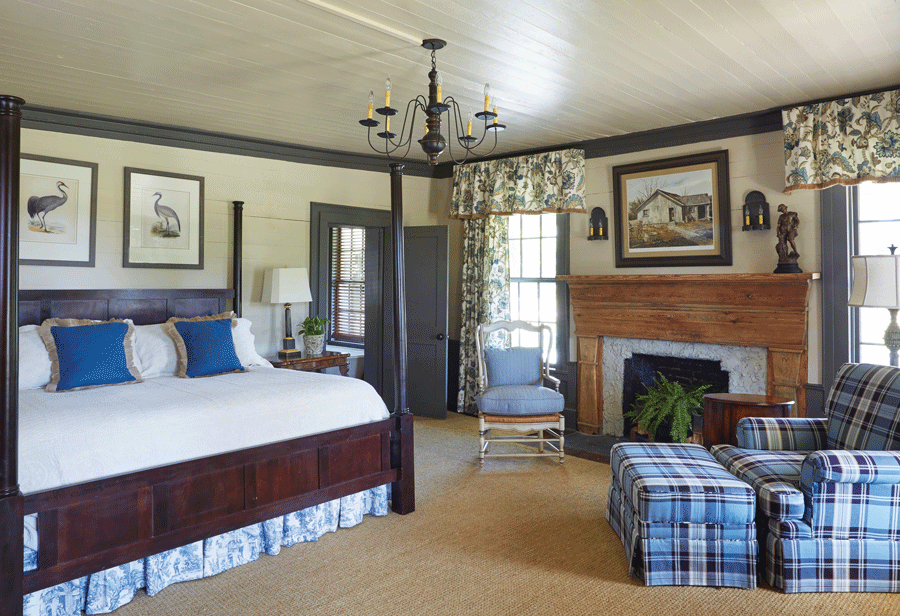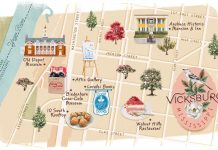
In the Appalachian foothills of east Alabama, the past is never far away. The region, once ruled by the Creek Indians, transformed into a patchwork of cotton fields in the nineteenth century, spawning textile boom towns like Alexander City. Around the same time, the pure veins of crystallized rock discovered near Sylacauga led to quarries and eventually attracted sculptors. Today, a traveler encounters this rich history in small museums, public sculptures, even in gaping quarries.
And while the area has added upscale touches, like a vineyard, a golf resort, and sophisticated restaurants, it remains a delightful no-Interstate zone of small towns, quaint stops, and quirky attractions. Start your journey on U.S. Highway 280, which offers easy access to this ever-evolving Heart of Dixie.

Morgan Creek Winery
Morgan Creek Winery
It might be surprising to find a tasting room across from a cotton field, but Alabama’s largest winery, located in Harpersville, doesn’t try to be a mini Napa. “Grits don’t come from California, and Chardonnay doesn’t come from Alabama,” explains an unapologetic Charles Brammer Jr. Instead, his family makes wine with the Deep South’s native grape, the muscadine, as well as other local fruits such as Chilton County peaches and North Alabama apples. Have a seat at the cozy gift shop bar for a free tasting of top sellers like the fruity, off-dry Vulcan Red. With a clever selection of wine-themed merchandise, a you-pick vineyard, and a summer jazz and fireworks program, there are plenty of reasons to raise a toast to Morgan Creek. morgancreekwinery.com

Alabama Tourism Office
DeSoto Caverns Family Fun Park
For Al Mathis, the family business is literally a hole in the ground. Back in 1912, his great-grandmother purchased a cavern outside Childersburg and the family has owned it ever since. At various times, it was an onyx mine and a Prohibition-era speakeasy; now it’s a glittering show cave. Mathis and his wife have lived in the aboveground gift shop ever since he took over in 1975, and today his daughter and son-in-law work at the property too. It’s a mini theme park with surprising attractions like a water balloon battleground, an archery range, and a unique wooden crawling box, which lets flexible guests twist, climb, and bend their way through a 200-foot maze. The cave’s appeal spans generations as well: Young and old alike are wowed by its laser-illuminated main hall, which is longer than a football field and could house a twelve-story building.
desotocavernspark.com

R. Steven Norman, III
Kymulga Grist Mill & Park
From the trails along Talladega Creek outside Childersburg, it’s easy to catch a glimpse of the nineteenth century. That’s when a graceful 105-foot covered bridge (now reserved for pedestrians) saw horse-drawn traffic, and a four-story mill house ground grains for local farmers. (It still produces and sells grits and cornmeal today.) After strolling along the bridge, visitors may rent canoes or hike their way into the past. Look for caretaker Bill Austin at the gift shop: He’s happy to offer a mill tour and fill in the history. kymulgagristmill.com
Isabel Anderson Comer Museum and B.B. Comer Memorial Library
For a little town, Sylacauga has made its mark on the nation’s cultural history. Its delightfully ramshackle city museum has a room devoted to local boy Jim Nabors, best known as Gomer Pyle on the Andy Griffith Show. Down the street, take another nostalgic trip at the public library, which displays eighteen oil paintings featured in 1940s Saturday Evening Post ads for local Avondale Mills. Famed illustrator Douglass Crockwell used mill employees as models in heartwarming scenes of fishing holes, soda fountains, and delivery rooms; fittingly, the results evoke the spirit of Norman Rockwell. comermuseum.weebly.com, bbcomerlibrary.net

Pursell Farms
Pursell Farms
One of Alabama’s most exclusive resorts owes its start to a family-owned fertilizer company. In 2003, the Pursell family opened FarmLinks course in Sylacauga as a playable grass showroom, and when word got out about the beautiful and demanding fairways twisting through the Appalachian foothills, it began to win honors. (Last year, GolfWeek magazine again named it the best public course in Alabama, a high bar given the state’s celebrated Robert Trent Jones Golf Trail.) The family added plush cottages, and a lodge is set to open this spring. The goal is to become Alabama’s Blackberry Farm, and achieving it seems possible, thanks to an Orvis school and shooting grounds, plus top-notch food. The Grille at the Clubhouse showcases the culinary creations of chef Andrea Griffith, who won honors at West Virginia’s famed Greenbrier Resort. pursellfarms.com
Gravity Hill
The Deep South, as we all know, has its own rules and way of doing things, which might explain why gravity seems to have lost its hold on visitors taking a spur off 280 just west of Sylacauga. As drivers discovered years ago, when you put your car in neutral, it appears to roll uphill. Killjoys say it’s just an optical illusion, but if that’s the case, it’s an awfully good one. We think Isaac Newton would be baffled. Set your GPS to Gravity Hill Lane

Alabama Tourism Office
Blue Bell Creamery
People get a little nutty about Blue Bell ice cream, which has found its way to Camp David and the International Space Station—NASA scientists claimed it helped boost astronauts’ “happiness quotient.” Back on Earth, Sylacauga’s plant welcomes pilgrims who come to watch the dessert’s production from observation windows and shop for everything from professional-grade scoops to shirts promoting the new Camo ’n Cream flavor. Tastings will set you back a mere buck a cup—if you’re lucky, the counter will be staffed by Wanda, who admits to having a heavy hand with the scoop. bluebell.com

Larry Bleiberg
Falling Star Statue
Back in 1954, Ann Hodges was napping on her couch when she was literally touched by the heavens. A meteorite smashed through her roof and struck her thigh, making international news. The house is gone, but Sylacauga remembers the incident with a beautiful abstract marble statue in front of city hall called Falling Star. And that’s not the only rock on display. A quarry, visible from a Highway 280 overlook, yields the area’s famous white marble, which is comparable to Italy’s famed Carrara. It’s used for industrial production and home design, as well as memorials in Arlington National Cemetery. sylacauga.net

SpringHouse Restaurant
SpringHouse Restaurant
It might seem strange to find a James Beard–nominated chef in east Alabama. But if you know the Russell family story, it makes sense. A century ago, patriarch Benjamin C. Russell launched a textile mill in Alexander City that eventually became Russell Athletic. After the Second World War, the firm bought up shoreline along newly built Lake Martin. Now the area, managed by the Russell Lands company, is dotted with million-dollar homes and served by a top eatery, developed in part by Birmingham restaurant legend Chris Hastings. From the chef’s counter, you can watch his protege Rob McDaniel create upscale Southern dishes such as rabbit and dumplings. Insider tip: Ask if his family-inspired chess cake is available; it may be the best dessert in Alabama. springhouseatcrossroads.com

National Park Service
Horseshoe Bend National Military Park
You would never know it now, but a quiet bend in the Tallapoosa River changed the course of the nation. In 1814, Gen. Andrew Jackson launched an assault on the Red Stick band of the Creek Indians, slaughtering an estimated 800 warriors. It was the last major battle of the Creek War, which added 23 million acres to the United States and helped make Jackson a national hero, setting the stage for his presidency and the Trail of Tears. The National Park Service makes it easy to understand how the combat unfolded: A film clearly tells the story, and exhibits at the visitors center provide context. Still, it’s the drive along the three-mile loop through the killing fields that brings the battle to life. nps.gov/hobe




![The North Carolina Museum of Natural Sciences’ newest exhibit is a [pre]historic first](https://cdn2.atlantamagazine.com/wp-content/uploads/sites/4/2024/04/DD-3-218x150.jpg)






![The North Carolina Museum of Natural Sciences’ newest exhibit is a [pre]historic first](https://cdn2.atlantamagazine.com/wp-content/uploads/sites/4/2024/04/DD-3-100x70.jpg)


